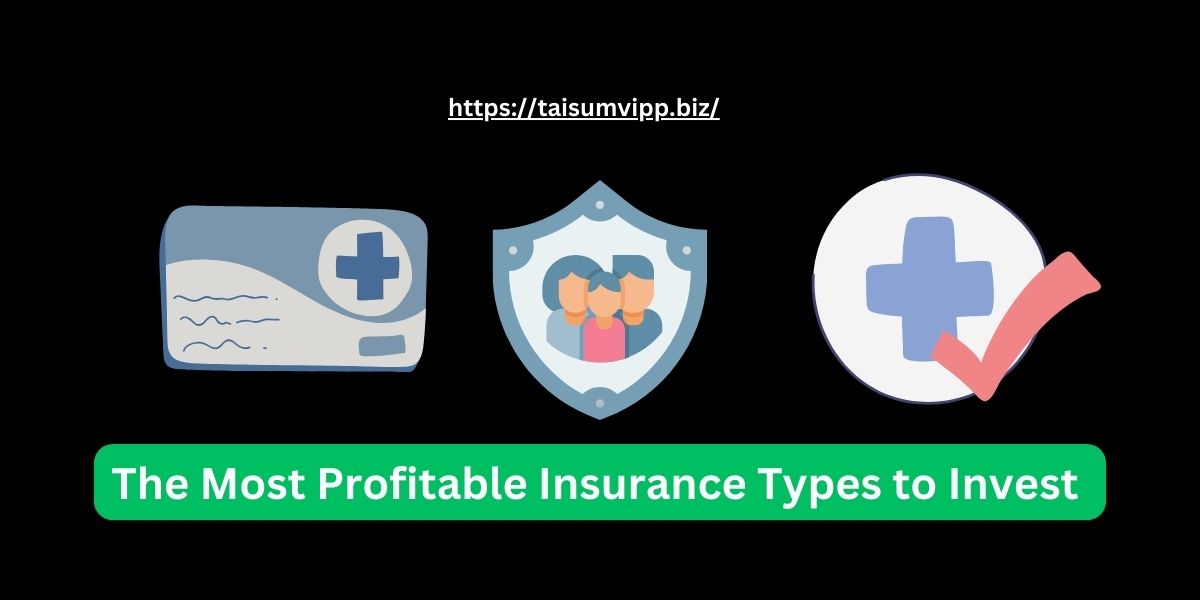Understanding the dynamics of insurance as an investment can be daunting, yet it is essential for anyone looking to enhance their financial portfolio. This article delves into the most profitable insurance types available for investment, providing insights and strategies for success.
Defining Insurance Investment
Insurance investment refers to allocating financial resources into various types of insurance products that not only offer coverage but also present opportunities for growth, returns, and profit. Unlike traditional investments, insurance investments combine elements of risk management with the potential for monetary gain.

This investment type encompasses a range of products, including life, health, and auto insurance, each serving distinct purposes and offering unique benefits. Understanding these facets is vital for investors seeking to leverage insurance for financial prosperity.
For instance, whole life insurance policies not only provide a death benefit but also accumulate cash value that can be borrowed against or withdrawn, making them a dual-purpose financial tool. Similarly, health insurance can protect against high medical costs, which can otherwise derail financial stability, while also offering wellness benefits that can reduce long-term expenses.
The Role of Insurance in Your Investment Portfolio
Incorporating insurance into your investment portfolio can serve multiple objectives. First and foremost, it provides a safety net against unforeseen circumstances. Additionally, certain insurance products can act as investment vehicles that accumulate cash value over time.
By blending insurance with traditional investments, such as stocks and bonds, investors can create a balanced portfolio that mitigates risks while aiming for maximized returns. The dual nature of insurance—protection and investment—makes it a valuable component of financial planning. Moreover, the tax advantages associated with many insurance products can enhance overall returns. For example, the cash value in permanent life insurance grows tax-deferred, allowing investors to benefit from compounding growth without immediate tax implications.
This feature, combined with the ability to access funds through loans or withdrawals, positions insurance as a strategic asset in long-term financial strategies, particularly for those looking to secure their family’s future while also building wealth. Additionally, products like annuities can provide a steady income stream during retirement, further emphasizing the multifaceted role of insurance in comprehensive financial planning.
The Profitability of Different Insurance Types
Life Insurance as an Investment
Life insurance remains one of the most commonly discussed investment options due to its dual character. It offers death benefits to beneficiaries and can accumulate cash value. Permanent life insurance policies, including whole life and universal life, are particularly popular for contribution towards investment growth.
One of the main advantages of life insurance is its tax-deferred growth. Policyholders can borrow against the cash value without facing immediate tax liabilities. Additionally, payouts upon death are generally tax-free for beneficiaries, enhancing its appeal as a long-term investment strategy.
Furthermore, the cash value component of permanent life insurance can serve as a financial safety net during emergencies. Policyholders can access these funds for various purposes, such as funding a child’s education or covering unexpected medical expenses. This flexibility makes life insurance not just a protective measure but also a strategic financial tool that can complement other investments, providing peace of mind in uncertain times.
Health Insurance Investment Returns
While health insurance is primarily viewed as a safety net against medical expenses, there are investment principles to consider. Health Savings Accounts (HSAs) paired with high-deductible health plans offer not only tax advantages but also investment opportunities.
Funds contributed to HSAs can be invested in various financial products, similar to retirement accounts. The returns gained over time while keeping pace with medical inflation can make HSAs lucrative, potentially yielding high returns in a tax-efficient manner.
In addition to traditional investment options, HSAs can also be utilized for long-term health care planning. As individuals age, the likelihood of incurring significant medical expenses increases, making HSAs a valuable resource. By strategically investing HSA funds, individuals can build a robust financial cushion to cover future health-related costs, ensuring that they are prepared for whatever challenges may arise in their later years.
Auto Insurance Investment Potential
Though auto insurance is often seen merely as a necessary expense, some innovative companies are beginning to explore how auto insurance could support investment strategies. Usage-based insurance policies can lead to lower premiums, creating savings that can be redirected into investments.
Moreover, as the automotive industry evolves with electric vehicles and autonomous driving technology, the landscape of auto insurance investment is shifting. Early investors in specific insurance tech companies could see significant returns as these changes unfold.
Additionally, the rise of telematics in auto insurance is transforming how premiums are calculated, allowing for more personalized and potentially lower rates for safe drivers. This not only incentivizes responsible driving behavior but also creates opportunities for drivers to invest the savings from reduced premiums into other financial ventures. As the market adapts to these technological advancements, savvy consumers may find themselves at the intersection of insurance savings and investment growth, further enhancing the profitability of their auto insurance choices.
Evaluating the Risks and Rewards of Insurance Investments
Risk Factors in Insurance Investment
Investing in insurance is not without its challenges. Various risks need to be evaluated, such as market volatility, changes in regulations, and the performance of underlying investments. For life insurance, the potential for high premiums and changing mortality rates can significantly impact returns.
Additionally, insurer solvency is a vital risk consideration; selecting financially sound companies is crucial to ensuring continued ability to pay claims and maintain policy values. Conducting a thorough analysis and seeking advice from financial professionals can help mitigate these risks.
It’s also important to consider the impact of interest rate fluctuations, as they can affect the returns on fixed-income investments held by insurance companies. A rising interest rate environment can lead to decreased bond prices, which may, in turn, affect the insurer’s overall financial health and their ability to fulfill policy obligations.
Potential Rewards of Insurance Investment
On the flip side, the rewards of investing in insurance can be substantial. The growth potential in life insurance cash values, the tax advantages of health accounts, and the security offered by solid insurers all contribute to attractive investment prospects.
Furthermore, as the demand for innovative insurance solutions rises, savvy investors can find opportunities in emerging sectors such as insurtechs, which blend technological advancements with traditional insurance models to create profitable market niches. These companies are leveraging data analytics, artificial intelligence,
and machine learning to streamline underwriting processes and enhance customer experience, thereby increasing efficiency and profitability. As these technologies evolve, they may also lead to the development of new insurance products that cater to the changing needs of consumers, presenting a unique avenue for investors looking to capitalize on the future of the insurance landscape.
Strategies for Successful Insurance Investment
Diversification in Insurance Investment
Diversification is a fundamental investment strategy that applies to insurance as well. By investing in a mixture of insurance products—life, health, auto, and even property insurance—investors can balance risk and opportunity, leveraging different market conditions to optimize returns.
This approach helps ensure that if one type of insurance product underperforms, others can provide stability and protect the overall portfolio value. A well-rounded selection can exploit various aspects of the insurance market effectively. Additionally, incorporating niche insurance products, such as pet insurance or travel insurance, can further enhance diversification. These specialized products often cater to specific consumer needs and can yield attractive returns, especially in markets where traditional insurance options are saturated.
Furthermore, geographic diversification can also play a crucial role in an insurance investment strategy. By investing in insurance products across different regions or countries, investors can mitigate risks associated with localized economic downturns or regulatory changes. For instance, while one region may experience a natural disaster leading to increased claims, another may see stable growth, thus balancing the overall performance of the investment portfolio.
Timing Your Insurance Investments
Market timing is essential for maximizing investment profitability. Monitoring changes in regulations, economic conditions, and demographic trends can guide when to adjust insurance holdings. For example, entering the life insurance market during periods of high interest rates can enhance the cash value growth of policies.
Investors should also remain alert to technological advancements impacting insurance. For instance, the integration of artificial intelligence in underwriting could influence policy pricing significantly, presenting prime timing opportunities for savvy investors. As technology continues to evolve, the rise of insurtech companies is reshaping the landscape, offering innovative products and streamlined services that can attract a new customer base. This shift not only creates potential investment opportunities but also necessitates a keen awareness of emerging trends, such as usage-based insurance models, which can provide competitive advantages in specific markets.
Additionally, understanding the cyclical nature of the insurance industry can be beneficial for timing investments. Economic cycles often influence consumer behavior and insurance demand. For instance, during economic downturns, consumers may prioritize essential insurance products, while in prosperous times, they might be more inclined to invest in additional coverage options. By aligning investment strategies with these cycles, investors can better position themselves to capitalize on market fluctuations and enhance their overall returns.
Future Trends in Insurance Investment
Impact of Technological Advancements on Insurance Investment
As technology continues to reshape the insurance landscape, its influence on investment opportunities cannot be overlooked. Artificial intelligence, blockchain, and big data analytics are driving greater efficiencies in underwriting processes and risk assessment.

Investors leveraging these technologies may find unique opportunities to capitalize on emerging insurtech companies or established players adapting to technological changes. Staying educated on these advancements is crucial for identifying lucrative investment prospects.
Predicted Market Changes and Their Effect on Insurance Investment
Market fluctuations, influenced by economic shifts and societal changes, will continually affect insurance investments. For instance, increasing awareness of health and wellness may drive demand for health insurance products, creating more profitable avenues for investment.
Moreover, environmental factors leading to more severe weather patterns could enhance the value of property and auto insurance. As these trends evolve, staying informed and adaptable can empower investors to make proactive decisions that align with emerging market dynamics.
In conclusion
understanding the most profitable insurance types to invest in can enhance your financial portfolio while providing essential coverage. By leveraging insights from this article, investors can navigate the complex landscape of insurance investment, enabling them to make informed decisions that align with their financial goals.



